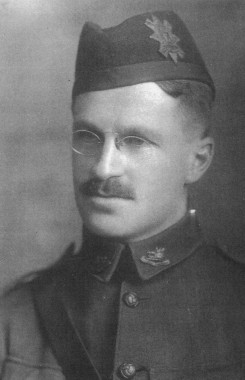The Life and Career of Captain James G. Ross of Embro
The Life and Career of Captain James G. Ross of Embro
By Liz Dommasch, Archivist
The son of David Robert (D.R.) and Annie (nee Munro) Ross, James Gordon Ross was born on Lot 9, Concession 5, West Zorra Township on February 1, 1879. He was raised in Embro, where his father operated an oatmeal mill and attended Embro Public School, before heading to Woodstock Collegiate Institute and, then later, McGill University, from which he graduated in 1903 with a Bachelor’s of Science degree in engineering.

It was while attending McGill University that he began the travels which were to take up such a large part of his career, and which were to prepare him later for his big job with Asbestos Corp. During his student days, he found time to do some practical mining in Rossland and Fernie, British Columbia as well as Cape Breton. Following graduation, his first job was a maintenance of way engineer with the Grand Trunk Railway, though he left his position soon after to trying prospecting in the Cobalt region, with little success. In 1906, he returned to railroading, assuming a position of engineer and superintendent of the Pennsylvania Tunnels under the Hudson River, New York. Two years, later he was working as manager of the Worthington Nickle Mines in Ontario and the Chrome Mine in Quebec.
Towards the end of 1908, James was commissioned by the Quebec government to study the methods used in other countries to mine chrome and asbestos deposits. While carrying out the assignment, he visited Europe, Africa, Asia, Australia and New Zealand. Returning to Canada in 1910, Ross continued his travels, examining properties in the brand new porcupine fields of Ontario, British Columbia and Alaska. In 1911, he was appointed consulting mining engineering for Milton Hersey.
With the outbreak of World War One, James enlisted at Valcartier on September 23, 1914 and served with the Black Watch Regiment (Royal Highlanders of Canada). Having previously served with the 22nd Battalion, Oxford Rifles, he rose to the rank of Captain, serving in France, where he was badly wounded at Festubert in 1915, fracturing his tibia and fibula from a high explosive shell. Unfit for active service, he returned to Canada, but would later be made Honorary Lieutenant-Colonel of the regiment.

On August 30th, 1921 he married Gladys Vera Miner, widow of Major Gilbert D. McGibbon. James continued his position with Milton Hersey, which saw the couple travel extensively across North and South America. In 1929, he accepted a position with the Asbestos Corporation at Thetford Mines, Quebec. At the time the business was struggling, partially due to the Depression, and partially due to the famous King Pit having reached its open pit depth limit. Throughout his travels, he had been impressed by the block caving system used in copper mines and felt that the method could also work in the asbestos industry. He was correct, and as a result all the company’s mining was later done by block caving, a method that saw the Asbestos Corporation having the lowest cost of any mining operation in Canada.

While working at the Asbestos Corporation, he raised to the positions of Vice-President and Manager. He also served as a director of the Royal Bank of Canada; president of the Canadian Institute of Mining and Metallurgy, in 1935; and general manager of Wartime Medals, from 1940-1945. In 1940, he donated $25,000 to the federal government to purchase a Spitfire fighter, which was named in his honour.
A member of the St. James and Mount Royal clubs of Montreal, James G. Ross passed away on September 21, 1968 and was buried in the North Embro Cemetery.
